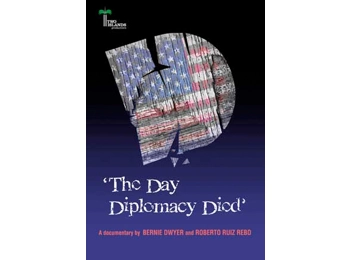The Day Diplomacy Died
Product Code: DDDDVD
Rating: Be the first to write a review
Weight: 100.0g
Product Condition: New
Review from MLToday.com
Bernie Dwyer and Roberto Ruiz Rebo have produced some excellent short documentaries about Cuba: Mission Against Terror (the story of the 5 Cuban political prisoners jailed in the U.S, One Man’s Story: Philip Agee, Cuba and the CIA, an interview with Agee about the CIA covert war against Cuba.
This film exposes the 75 so-called “independent journalists” and “independent librarians” arrested and jailed in Cuba in 2003. It interviews Jose Pertierra, lawyer seeking to extradite terrorist Posada Carriles from the U.S. to Venezuela, Vicky Huddleston, head of the U.S. Interests Section 1999-2002, Wayne Smith, the anti-U.S. blockade former head of the Interests Section (1979-82), and Ricardo Alarcon, president of Cuba’s National Assembly.
Through the stories of four Cubans recruited by the Cuban government who worked as undercover agents in the “dissident” movement, the film explains how the US Interests Section worked to create and finance civil disobedience and an internal opposition in Cuba. Interestingly one of the four Cubans recruited was actually a bona fide independent journalist in Cuba.
The film places the dissident movement as an integral part of the US covert war against Cuba. There has been U.S. created violence and terrorism against Cuba since the beginning of the revolution, including bombings, blowing up factories, sugar mills, department stories, biological warfare, assassination of Cuba government officials and everyday citizens.
The film references a 1961 directive to the CIA “to create inside Cuba an internal opposition to the regime through external financing.” It notes that US law has earmarked $80 million a year in the budget for subverting the Cuban government. “There is no other line in the US budget for subverting any other government,” states Pertierra.
The four Cubans infiltrated the dissident groups to document the extent of US influence over them. They were part of the defensive plan of the Cuban government to prevent the US government from creating, financing and directing an internal “dissident” movement. One explained that orders came all the time from the US Interests Section to foment unrest.
Another explained that these in the dissident movement were not “dissidents” but both mercenaries, paid by the U.S. to follow the orders of the Interests Section,, and counter-revolutionaries, seeking to establish a U.S. controlled puppet government in Cuba. Wayne Smith explained that for an Embassy or Interests Section to have dialogue with country’ s population is perfectly acceptable, but not to finance an opposition.
James Cason, the new head of the US Interests Section in 2002, brought the conflict to a head, seeking to create conditions of domestic unrest, and lead to Cuba shutting down the Interests Section. The 4 noted that the US Interests Section pressured the dissidents to create civil unrest and riots, with the plan that this would eventually give the green light to the OAS to ask the US Marines an excuse to intervene and "restore order". It was even noted that in Ciego de Avila, dissidents were about to plant bombs in the main streets of the city.
In the spring of 2003 the 75 mercenaries were arrested, and sentenced in summary trials. Remember, this was right after the apparent victories of the U.S. armies in Afghanistan and Iraq, which at the time were seen as the first of a number of U.S. invasions of other countries. In Cuba at the time, a number of armed hijackings to Miami had just taken place, and no hijackers had been jailed in Miami. As Fidel Castro pointed out elsewhere, quick and decisive action needed to be taken to defend the country.
Given what we learn from the interviews, it is unfortunate they are so short, as having inside information of this sort is an essential manner to counter US propaganda that these mercenary dissidents were "human rights" activists jailed by the Cuban police state regime.
Bernie Dwyer and Roberto Ruiz Rebo have produced some excellent short documentaries about Cuba: Mission Against Terror (the story of the 5 Cuban political prisoners jailed in the U.S, One Man’s Story: Philip Agee, Cuba and the CIA, an interview with Agee about the CIA covert war against Cuba.
This film exposes the 75 so-called “independent journalists” and “independent librarians” arrested and jailed in Cuba in 2003. It interviews Jose Pertierra, lawyer seeking to extradite terrorist Posada Carriles from the U.S. to Venezuela, Vicky Huddleston, head of the U.S. Interests Section 1999-2002, Wayne Smith, the anti-U.S. blockade former head of the Interests Section (1979-82), and Ricardo Alarcon, president of Cuba’s National Assembly.
Through the stories of four Cubans recruited by the Cuban government who worked as undercover agents in the “dissident” movement, the film explains how the US Interests Section worked to create and finance civil disobedience and an internal opposition in Cuba. Interestingly one of the four Cubans recruited was actually a bona fide independent journalist in Cuba.
The film places the dissident movement as an integral part of the US covert war against Cuba. There has been U.S. created violence and terrorism against Cuba since the beginning of the revolution, including bombings, blowing up factories, sugar mills, department stories, biological warfare, assassination of Cuba government officials and everyday citizens.
The film references a 1961 directive to the CIA “to create inside Cuba an internal opposition to the regime through external financing.” It notes that US law has earmarked $80 million a year in the budget for subverting the Cuban government. “There is no other line in the US budget for subverting any other government,” states Pertierra.
The four Cubans infiltrated the dissident groups to document the extent of US influence over them. They were part of the defensive plan of the Cuban government to prevent the US government from creating, financing and directing an internal “dissident” movement. One explained that orders came all the time from the US Interests Section to foment unrest.
Another explained that these in the dissident movement were not “dissidents” but both mercenaries, paid by the U.S. to follow the orders of the Interests Section,, and counter-revolutionaries, seeking to establish a U.S. controlled puppet government in Cuba. Wayne Smith explained that for an Embassy or Interests Section to have dialogue with country’ s population is perfectly acceptable, but not to finance an opposition.
James Cason, the new head of the US Interests Section in 2002, brought the conflict to a head, seeking to create conditions of domestic unrest, and lead to Cuba shutting down the Interests Section. The 4 noted that the US Interests Section pressured the dissidents to create civil unrest and riots, with the plan that this would eventually give the green light to the OAS to ask the US Marines an excuse to intervene and "restore order". It was even noted that in Ciego de Avila, dissidents were about to plant bombs in the main streets of the city.
In the spring of 2003 the 75 mercenaries were arrested, and sentenced in summary trials. Remember, this was right after the apparent victories of the U.S. armies in Afghanistan and Iraq, which at the time were seen as the first of a number of U.S. invasions of other countries. In Cuba at the time, a number of armed hijackings to Miami had just taken place, and no hijackers had been jailed in Miami. As Fidel Castro pointed out elsewhere, quick and decisive action needed to be taken to defend the country.
Given what we learn from the interviews, it is unfortunate they are so short, as having inside information of this sort is an essential manner to counter US propaganda that these mercenary dissidents were "human rights" activists jailed by the Cuban police state regime.
€10.00 inc. tax
Customer Reviews
No Reviews Posted Yet - be the first! (write review)

